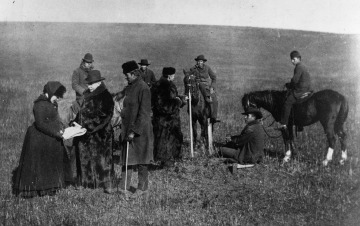1887: U.S. subdivides reservation land; sells off surplus
Congress passes the General Allotment Act, better known as the Dawes Severalty Act, which divides reservations into individual land allotments, usually of 160-, 80-, and 40-acre parcels. The allotment system responds to a widely held belief in the U.S. that Indians should be “civilized” by ending their communal existence and by promoting individual property ownership. Reservation land not allotted to individual Indians is declared surplus and offered for sale.
The intent of the Dawes Act is to dissolve tribal lands and tribal leadership, and assimilate Indian families—but its results are catastrophic. Between 1887 and 1934, more than 86 million acres, which represent more than 60 percent of the remaining Native land, pass into non-Native hands. As land is leased or sold for development, housing, or farms, Indians lose access to traditional hunting, fishing, and gathering sites. Wild foods important to Indians diets since time immemorial become extinct or inaccessible, forcing families to rely on government rations.
- Theme
- Federal-Tribal Relations, Land and Water, Native Rights
- Region
- California, Great Basin, Great Plains, Northeast, Northwest Coast, Plateau, Southeast, Southwest
A delegation allots land to the Nez Perce, ca. 1860–1877
Courtesy Denver Public Library, Western History Collection.
